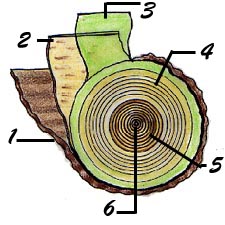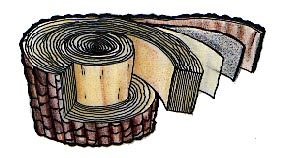 1.The outer bark protects the tree from extreme
temperatures, bad weather, insects and fungi.
Very thin in birch trees, the outer bark may be
one foot thick in the Douglas fir.
1.The outer bark protects the tree from extreme
temperatures, bad weather, insects and fungi.
Very thin in birch trees, the outer bark may be
one foot thick in the Douglas fir.
| MadSci Network: Botany |
There are six main parts to the wood of a tree.
 1.The outer bark protects the tree from extreme
temperatures, bad weather, insects and fungi.
Very thin in birch trees, the outer bark may be
one foot thick in the Douglas fir.
1.The outer bark protects the tree from extreme
temperatures, bad weather, insects and fungi.
Very thin in birch trees, the outer bark may be
one foot thick in the Douglas fir.
2.The phloem (bast) is also called the inner bark. It conveys the food-bearing sap developed in the leaves down to the various parts of the tree.
3.The cambium is a thin layer of cells which produce phloem on one side and sapwood on the other.
4.Sapwood is the living wood in the tree through which the raw sap rises from the roots to the leaves.
5.The heartwood consists of old cells. This is the dead part of the tree that nevertheless provides structural strength. If air could reach these cells, the heartwood would rot quickly.
6.The pith is the central core of the tree.
 Each year, the tree forms new cells, arranged in
concentric circles called annual rings or annual
growth rings. These annual rings show the amount of
wood produced during one growing season.
Each year, the tree forms new cells, arranged in
concentric circles called annual rings or annual
growth rings. These annual rings show the amount of
wood produced during one growing season.
In Canada, the growing season begins in the spring. At first, the cambium produces numerous large cells with thin walls that form the springwood (earlywood). If you look at a cross section of a tree, this is the light-coloured ring.
Then, towards the end of the summer, growth slows down. The cells manufactured at this time of year are small, with thick walls. They form the summerwood (latewood) which appears as a darker ring on the tree cross section.
One year of growth is therefore represented by a ring consisting of a light part and a dark part. The darker wood is not formed in winter, as some people believe, because the cambium is completely inactive in the winter.
The following year, a new two-part ring is added. The older rings are closest to the centre of the tree. The tree grows in diameter because it manufactures new cells around its circumference, not because the old cells get larger.
The old annual rings form the heartwood of inactive cells: this is the dead part of the tree. The live portion includes only the most recent rings. Depending on the tree's age and species, this portion is 1.5 to 7.5 cm wide. The dead wood is the largest part of the tree. Often, it takes on a darker colour.
Annual rings generally exist in trees where the climate halts growth at some point during the year. In our country, winter causes this shutdown. In other countries, it is the dry season. Growth begins again in the spring or rainy season.
But what happens to trees growing in countries where there is no alternation between growth and rest periods?
For example, a country where it rains all year long! Remember that all trees grow by adding successive rings. So in such an area, the beginning and end of the growth period may occur any time during the year, depending on the local conditions.
This excellent explanation of the parts of trees and these wonderful drawings were taken from The World of Trees at http://207.183.56.85/english/start2.htm.
Keep asking questions!
-Marcy LaViollette
Try the links in the MadSci Library for more information on Botany.